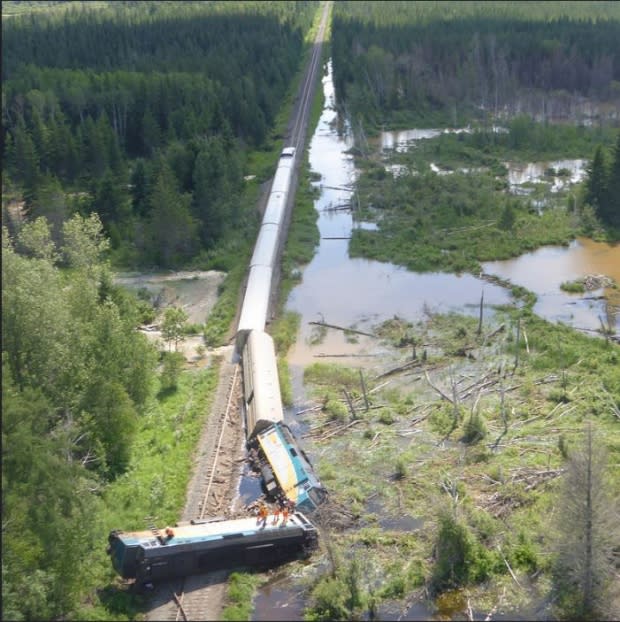Highways workers saw washed-out road 2 days before July derailment near Hudson Bay, Sask.
Two days before a VIA Rail derailment north of Hudson Bay, Highways employees had seen a partial washout at the nearby highway following heavy rains, according to the Transportation Safety Board.
But the Saskatchewan Ministry of Highways and Infrastructure and the railways do not have protocols in place to share information about the protection of infrastructure, said the TSB, writing that it's "critical" this information is shared in the future.
The TSB has released its investigation report into the July 6, 2018 derailment. It looks at the circumstances leading up to the crash, in which two locomotives and two cars derailed, coming to rest on the washed-out single main track.
Heavy rains that week saw forest debris accumulate and eventually overwhelm the culverts, leading to the washing out of nearby Highway 9, which lies at a higher elevation than the railway, according to the report.

On July 4, highway employees saw Highway 9 was partially washed out, but that roadway culverts were still in place. They could not see the rail line from this location, according to the TSB report. With the highway breached, the excess water flowed overland and flooded the railway right-of-way between two railway culvert locations.
"Eventually, the trackbed washed out, leaving the track unsupported at the occurrence location," read the report.
The VIA train had departed from Canora, Sask. on its way to The Pas, Manitoba. When it departed, the crew was told to be on the lookout for high water near Otosquen, Sask. They saw a number of locations with high water next to the track. The train was moving at about 56 km/hr when the crew once again became concerned.
"As a precaution, the crew began to slow the train."
At 3:06 a.m. CST, while travelling at 53 km/hr, the train came across the washout. The locomotives jackknifed, going off the rails and coming to rest on their sides. The second locomotive was partly submerged in the water.
A baggage car also derailed, leaning at a 40 degree angle, while a passenger coach also went off the track, coming to rest upright. Three other passenger coaches and the observation car remained upright on the track.
The crew made an emergency radio broadcast, calling for help from the remote location, which was inaccessible by road. CN Engineering personnel arrived to help by 4:30 a.m. CST, evacuating the 16 passengers and five crew members. Two crew members were treated in hospital and released later that day.
The report noted that CN has taken new safety steps following this crash, including modifying its warning system to identify the accumulation of precipitation and to let out a warning when water capacity thresholds are reached.
It will also increase patrols to monitor drainage along the railway right-of-way when rainfall happens over multiple days, following a severe weather advisory or when it learns that a certain area will exceed 40 mm of continuous rain.

